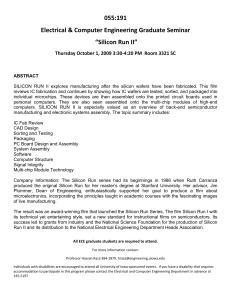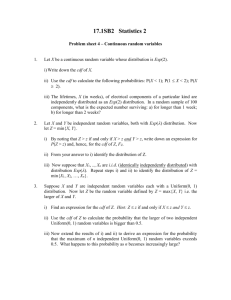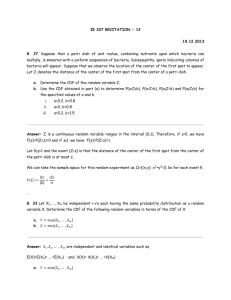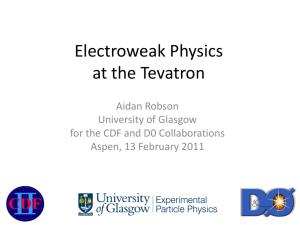UK CDF
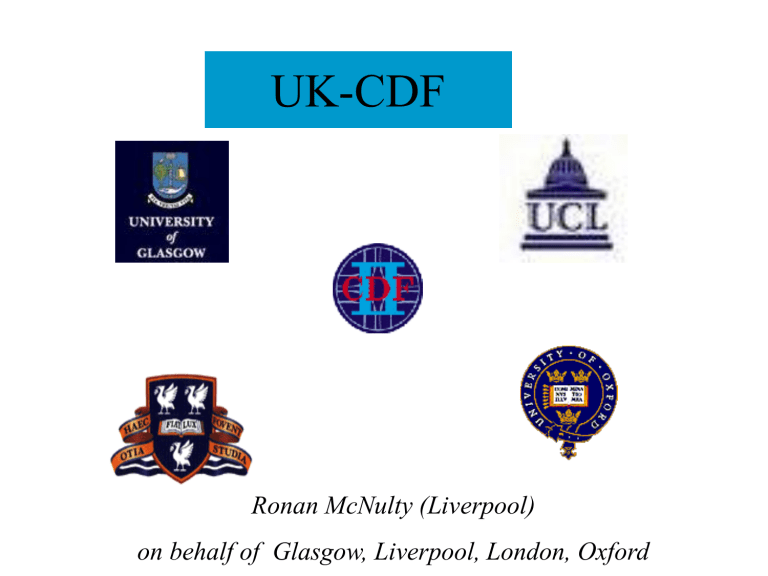
UK-CDF
Ronan McNulty (Liverpool) on behalf of Glasgow, Liverpool, London, Oxford
Overview
• Tevatron Operations
• Hardware
– Layer00
– SVX
• Software
– Silicon Monitoring and
Alignment
– Level 3 Trigger
– CDF Database
– Computing
• Physics Analyses
– B physics
– Electroweak
– Searches
• Comments &
Conclusions
Tevatron Operations
• Commissioning Run
• 7 fills: Oct 8 th – Nov 4 th
• Max lumi: 4x10 29 cm -2 /s with 36x36 bunches
• 57.6nb
-1 integ. lumi.
• All detectors installed bar
Silicon. 6% proto-type instead.
• Level 1,2 & 3 triggers
• Full DAQ
•
Run II
• April 3 rd 2001 LHC startup
• Max lumi: 7.9x10
30 cm -2 /s
• 7.2pb
-1 integ. lumi.
• Expect 2000pb -1
• CDF essentially complete
• Level 1 (2) 3 triggers
• Physics quality data
Layer 00
• Layer00 is the silicon detector closest to the beampipe. R=1.6cm
• UK designed & purchased the silicon.
• Designed and constructed the two 50cm long carbon fibre support structure and cooling.
• Irradiated and tested kapton cables
• Performed cooling studies
Narrow plaquettes
Cooling channel
Wide plaquettes
Sit here
Size of
Beampipe
Carbon fibre prototype
Layer 00 construction
Wide silicon mounted here
Assembly jig
Narrow silicon mounted
Hybrid
Layer00 Performance
1/6 of Layer00 taking data (due to power supply delays)
Tracks observed in silicon Charge deposition in silicon
SVX
Two wedges of SVX
Implemented for
Commissioning Run
One of Three Silicon Barrels installed for Run II.
SVX Testing
Performance of SVX
Correlation of charge deposited on n and p sides, for data taken with a ruthenium source
UK first to see beam profile
Combined efforts of silicon expertise, database (pedestal update), and tracking algorithms led to first observation of the beam during Commissioning Run
Silicon
Layers
Beampipe
Residuals from Si hits to circle fit cm
Overlay of many events with pT>100MeV
Silicon Monitoring
• Comprehensive monitoring tool
• Online: for rapid reaction to problems
• Offline: for detailed studies and record of performance over time
• Implementation:
– Define quantities
– Create histograms
– Intuitive GUI
R f hits
Barrel 0 Barrel 1 Barrel 2
R f hits on tracks
R v z for hits on tracks
Silicon Alignment
Alignment vital for b tagging, B lifetimes, oscillations, CP violation, and searches
Perfect
Alignment s
= 14 m m
Impact Parameter (cm)
Before s
=40 m m
After s
=15 m m
Impact Parameter (cm)
Impact Parameter (cm)
Level 3 Trigger
Level 3 Trigger
• Software Trigger
(In 500Hz; out
75Hz)
• Fast event reconstruction on
250 CPUs.
• Operating since commissioning run
• UK coordination and 24 hour support
• Automated system for code validation
• Regional tracking algorithms for full offline reconstruction in selected detector regions
The CDF Database
• UK responsible for delivering the CDF database, online and offline.
• Acquire, store, provide information about the data and running conditions.
• Online: real time storage from hardware, run control, trigger, monitoring, calibration
• Offline: deliver to reconstruction and physics analysis.
• Coordinate consultants, schema designers, computer system experts, users.
The CDF Database
• Start: structure insufficient for expected size and usage
• Poll hardware and software experts
• Implement new management structure
• End: 30GB database created which handles
50,000 accesses/day.
99.8% up-time.
• Prototype database export system setup and in test between FNAL and UK.
5 dbAdministrators
7
C++/Oracle physicist
40
Application programmers
Tools
500
Users
Computing
• Coherent UK strategy on computing
• >1Petabyte of data
• £1.8m grant from JIF
– 4/5 for high-speed, high-volume disk
– 1/5 for networking
• Committed half so far
– Universities & RAL
:
8-way SMP server with fibre channel to 1TB
RAID
– Universities at FNAL :
8 dual-processor PCs
– FNAL : 10TB RAID
Direct Contribution from UK to CDF
Accelerator Work
• Improve performance of
Tevatron
• Several 10% improvements possible
• Request for effort
• Optimise lithium lens design (p collection)
• Model production and propagation
• Create visualisation tool for machine physicists
• Three UK technicians helping (travel paid by
FNAL)
• One UK student
(funded by FNAL)
Physics Analyses
• B physics: Lifetimes and Oscillations
• Electroweak Physics
• Searches: SUSY and Higgs
B lifetimes
• First measurements which CDF will perform in b sector
• Necessary step towards oscillation
• (Test of alignment, tracking, tagging.)
• Best measurement of
B s
0 ,
L b
. (Unique)
HQET: t
(B + )/ t
(B 0 )=1.05
t
( B s
0 )/ t
(B 0 )=1.00
t
(
L b
)/ t
(B 0 )=0.9 to 1.0
Experiment: t
(
L b
)/ t
(B 0 ) is 0.78+-.04
B lifetimes
B lifetime
Millions of B mesons have already been produced in RunII.
Need to trigger and identify relevant decays. Leptons ‘easy’; hadrons difficult
Run II data: tracks with
Silicon hits
Run I data:
UK thesis topic
Look for J/ y mm
Search for B +
J/ y K
+
Bs oscillations
• Lifetime measurements: prelude to oscillations
• For B mesons, Flavour eigenstates
weak eigenstates
• So B 0 B 0
• Mixing parameter: x = D m/
G
• LEP/Barbar: x d
= 0.73
To date: x s
> 14.6
Tevatron unique
• Usually measure by oscillating exponential; UK has developed new complementary method
P
B
(t)
e -
G t (1+cos(
D m t))
B oscillations
• D m DG = f (t
H
, t
L
)
• Separate eigenstates and measure each lifetime
1) B
S
D
S
+ D
S
(CP even)
Work continuing in triggering on these difficult hadronic modes
(track/vertex/reconstuct)
2) B
S
J/ y f
(CP even&odd)
Different angular distribution for mm allow separation of CP even and odd states
3) B
S
J/ y h
(CP odd)
B oscillations
Search for B
S
J/ y h.
UK Thesis with Run 1 data
Br.( B
S
J/ y h
)<8.75 x 10 -4 at 90% c.l. (Prelim)
Electroweak Physics
• Introduce new W and
Z simulations to CDF
• Calculate systematic uncertainty on W mass from higher orders.
• Conclude (2fb -1 )
– W mass to 30MeV
– W width to 40MeV
• Studying muon and electron identification
Electroweak Physics
Electroweak Physics
Z
mm candidate
SUSY
• Studying lepton spectra for sensitivity to different
SUSY models (eg. gluino pairs)
• Builds on electron/muon identification
• Specific search for chargino decays
c
+
c
0
2 c
0
2 l n
c
0
1
• 3 leptons often l l enriched in taus
Higgs
Higgs search will be highlight of Run II for CDF/D0.
Standard searches may exclude but not discover Higgs to 180GeV
Higgs
• Largest production mode is gg
H
bb
• …. but QCD background enormous
• We can reconstruct bb with 10-15 GeV.
• …. Suppose we could reconstruct with 200
MeV
Higgs
Look in diffractive mode pp
pHp
Reconstuct from missing mass of pp system
CDF
55m
Large theoretical uncertainties exist as discussed at IPPP
Durham last week. Theoretical & Experimental clarification required before proceeding to CDF approval or build.
Higgs
UK CDF Personnel
•
Glasgow (2.6 FTE)
– S. d’Auria
–
P. Bussey
–
R. St.Denis
– S. Thomson
– 5 students
• Liverpool (5.9 FTE)
– P. Booth
– B. Heinemann
– M. Houlden
– B. King
–
S. Marti
–
R. McNulty
–
T. Shears
–
A. Taffard
–
2 students
•
Oxford (4.7 FTE)
–
F. Azfar
–
T. Huffman
–
J. Loken
– L. Lyons
– J. Rademacker
– A. Reichold
– P. Renton
–
D. Waters
–
4 students
• UCL (2.1 FTE)
–
M. Lancaster
–
R. Snihur
– D. Waters
– 3 students
Conclusions (I)
• Relativity small number of physicists:
15.3 FTE + 14 students
• High profile on experiment of 500 people
• Very attractive to students and postdocs
• Value for money
•Limited funding is having an impact on recruitment, profile and physics
•Further to continual maintenance, we need to exploit out investment by producing physics.
Conclusions (II)
• UK have delivered major components of CDF:
Layer00, Level 3 Trigger, Database.
• UK coordinate/are responsible for: Database, Level 3,
Silicon Monitoring, Alignment
• Understanding Detector: Silicon, Tracking, Muons,
Electrons
• Physics Analysis underway: B physics, Electroweak,
Searches
• Coherent UK hardware/software effort with common data model (JIF) & common physics goals.




